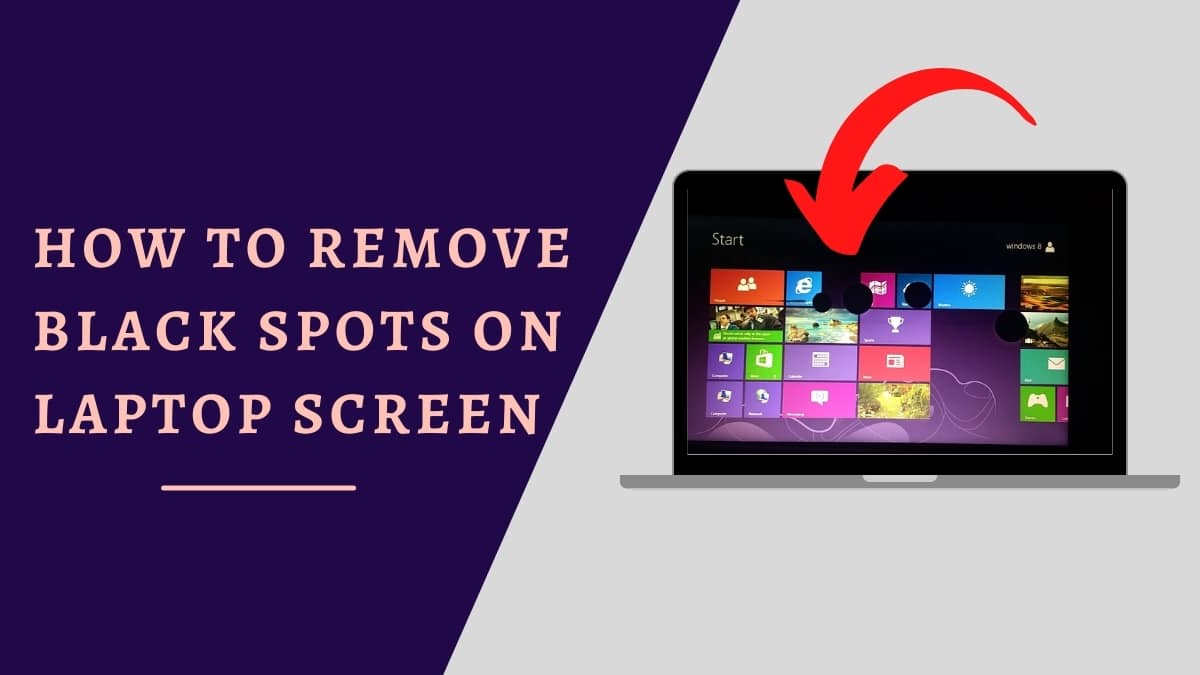Is there a black spot showing up on your computer screen? Has it checked right away to make sure it’s not some malware or virus? If you don’t know how to find someone who does.
Most people don’t know why they’re getting these black spots on their laptops, but here are some factors that contribute to this problem happening.
Table of Contents
Factors Responsible for Black Spots
Let’s talk about those pesky black spots on your laptop screen. There are many causes and here are just a few.
1: Stuck Pixels
Screens are covered in an even distribution of thin, liquid crustal that can dry up and leave behind a spot. As it dries up or moves, the panel’s interior bonds – and it can’t go back to its original position. This often leaves people with stuck pixels on their screens that never change color or go away no matter what they do.
Some laptops might accumulate small chunks of dirt or even dust that gets lodged between the pixels. These stuck pixels can take on one of five colors – red, blue, white, green, or black – depending on what color they’re currently set to display.
2: Dead Pixels
There are two types of dead pixels. Stuck pixels consist of three diodes – one each for the colors red, blue, and green. If anyone or more of these three dies then you’ll see a black dot on your screen. Dead pixels require just one diode to go out for there to be an area where nothing shows up on-screen at all.
3: Dust and Dirt
Besides, dust and dirt are two of the many reasons for spotting. It sticks around for a long time accumulating on our computer screens, but we still forget to clean it off.
4: High Temperature
You can tell if there is a problem with your computer or laptop when you see spots on the screen. If high temperature is to blame then this could cause problems, too. Computers and laptops are sensitive to heat and overheat more easily than being in the cold so it’s important to take care of them!
This can eventually lead to software malfunctions, such as that the device will either shut down or start running sluggishly. Additionally, if the computer is too close to a heat source for an extended period of time, it will develop dark patches on its screen due to pixel degradation – which is also known as ‘matrix delamination’.
5: Physical Damage
It’s a scary reality that some of us experience every day- you wake up in the morning after having a nightmare only to find out that your phone has been thrown across the room while you were asleep. And you don’t even remember doing it! So, sometimes when these things happen, there are some visible dark spots on my laptop display screen- but I know what they’re from!
6: Manufacturing Defects
Malfunctioning products are nothing new for manufacturers. During production, there may be some discrepancies with the screen’s display matrix. This could lead to the appearance of black spots on laptop screens.
7: Moist or Dry Air
Humidity and dry air aren’t good for electronics. Too much humidity can cause condensation, corrosion, or worse! Make sure you keep those devices in decent shape by wiping them down with a damp cloth now and then – this will help to prevent any problems from cropping up.
We should avoid it. Avoiding both moisture and dryness is key – whether we’re talking about humidity or temperature – since they can result in electric discharges which could render our gadgets useless. We need to keep our devices in spots where they are comfortable (with enough moisture) and don’t feel too hot or cold (so that they stay properly ventilated).
Methods of – How to Fix Black Spots on the Laptop Screen
1: Fixing Stuck Pixels
You can solve the problem of stuck pixels by yourself. Utilizing a light cloth such as a microfiber material, clean off your screen. Select any pencil or stylus that has an eraser on the end. Gently rub it over the defective area until all ills are fixed!
Remember to cover the area of the screen that has a stuck pixel before you start rubbing it. You can’t apply too much pressure or else you might damage your screen. Usually, if the problem isn’t solved then, go on step 2 which is downloading some software.
2: Fixing the Dead Pixels
Pick up the soft cloth and rub the dead pixel area gently. This may help the pixels relearn how to see colors again, so they might regain their original tone.
3: Downloading Software
In the event that you are unable to repair your own graphics card, installing pixel fixer software on your computer may help. From there, all you need to do is visit screen fix and follow their instructions; all of which are available through an online option or an offline installation file.
It’s crucial to update your java in order for it to work properly, or else there could be negative consequences. Updating java is necessary, but where do we find it? You don’t have to worry because you can go to the website and download it immediately. Keep in mind that once you update Java, all of its settings will change automatically and may require some adjustments if things aren’t working properly.
If a little dot appears on your laptop’s display when you look at it, don’t worry. Just press Ctrl + Alt + Delete keys together and hold it for 10 seconds or so until the stuck pixel issue pops up. Click Fix on the pop-up menu and let our service do its job–finding broken pixels and fixing them. Or if you prefer to work manually, there are many ways such as clicking refresh while pressing down two fingers simultaneously or doing some random movements with your mouse or trackpad cursor over this tiny dot of white light.
4: Check Brightness Level
Go through your settings and make sure you are comfortable enough with your brightness level.
5: Check for Hardware and Software issues.
Every now and then, computers may experience malfunctions due to either software or hardware issues. Depending on the problem at hand, one may consider checking drivers, display settings, viruses, and other related settings (for software) or opening up and closing the lid of their computer (to rule out any flickering). One can solve most software issues themselves but will likely need a professional for fixing hardware malfunctions.
6: Backlight Fixation
In some cases, there are problems with the backlight which dims and turns black while watching videos or working on your laptop. This occurs because bulbs burn out – but you can fix this by changing it for a new one.
7: Contacting Manufacturers
If you cannot fix the stuck or dead pixels, try running the software again. It might correct the issue. If it persists, please contact the manufacturer. They will replace your screen if your device is still under warranty and satisfies all of its conditions.
8: Purchasing New Panel
The problem won’t go away if you’re stuck with a laptop computer. You need to buy a replacement screen so it’ll work again. But there are special steps you need to take when replacing screens on a laptop vs desktop computer.
Tips to Avoid the Black Spots
Fixing black spots can be a hassle. To avoid it, you need to know how to prevent it from happening in the first place.
1: Removal of Dirt
Instead of using scratchy fabrics or wet rags, use a microfiber cloth to wipe down your screen and you’ll keep it looking new. Take care not to use any liquid that contains alcohol, acetone, or ammonia when cleaning your monitor because these substances can harm the display.
Dust prevention and preservation are crucial for keeping your screen in top condition. Prevent those pesky black spots from showing up on your screen by wiping it down every few days with a dampened microfiber cloth – white vinegar and water mixed in equal proportions works best!
2: Maintaining a Proper Temperature
Laptops are fragile when they’re exposed to high temperatures. They don’t do well in intense heat- it’s been shown that high temperatures can cause overheating of batteries, HDDs, and other parts inside the laptop. So it’s important for all laptops to maintain an adequate ambient temperature so you don’t end up damaging your computer or risking injury from it.
3: Using a Humidity Sensor
If you don’t want your device to succumb to damage due to humidity over time, a humidity sensor or hygrometer will keep an eye on the moisture levels of your environment. Warmer temperatures make for more humid environments – and it’s wise to monitor this closely with either of these two devices so that you can keep the optimal amount of moisture in the air around your devices. As long as you use one of these two accessories, you won’t have any problems!
4: Working on a Laptop Desk
Preventing workplace hazards and ensuring optimal productivity is essential. Laptop desks provide the best working experience for laptop users.
5: Avoid Direct Sunlight
Keep your laptop out of the sun when you’re working outside, otherwise, it’ll overheat and either melt or fry.
6: Handle Your device with Care
Handle your devices cautiously. Especially when you’re out of town, take care of them properly. Don’t mishandle them or throw them around too much because they are expensive to replace! Keep your laptops in bags so they stay safe and don’t overheat during transport. Make sure you take breaks during long trips to the car so it doesn’t overheat!
If you’re traveling when it’s humid outside, make sure to keep your laptop out of the way so it doesn’t come in contact with high levels of moisture which could cause corrosion.
Conclusion
Dark patches of spots may appear on your screen due to several reasons. Such things include dirty or defective pixels, as well as physical damage. Dirt and debris are relatively easy to remove. A pixel problem such as ‘stuck’ or ‘dead’ is considerably harder to solve. However, if your laptop is still in warranty and has met all the criteria, then it will be able to be repaired by factory personnel at no additional cost; so make sure that you contact them soon enough!
You can fix small problems yourself but you may need to go to an expert for bigger issues. Preventing black spots can be as easy as keeping the right temperature and humidity, keeping your device clean, taking care of it with love, and protecting it from direct sunlight exposure.








